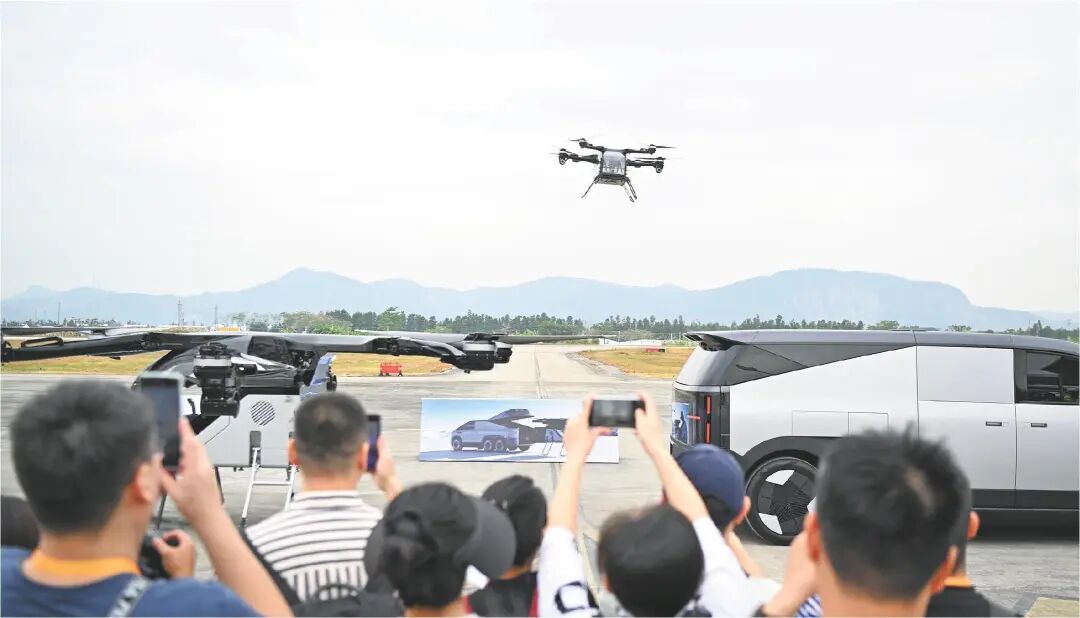The Low Altitude Economy Zone Debuts at the 15th China Airshow
How Shandong Enterprises Compete in the Low Altitude Economy
 On November 10, at the second exhibition area of the China Airshow, XPeng’s flying car “Land Aircraft Carrier” conducted a flight demonstration. The 15th China Airshow has set up a dedicated low altitude economy pavilion to comprehensively showcase enterprises and application scenarios related to the low altitude economy. (Reported by Xinhua News Agency, reporter Deng Hua)
On November 10, at the second exhibition area of the China Airshow, XPeng’s flying car “Land Aircraft Carrier” conducted a flight demonstration. The 15th China Airshow has set up a dedicated low altitude economy pavilion to comprehensively showcase enterprises and application scenarios related to the low altitude economy. (Reported by Xinhua News Agency, reporter Deng Hua)
From November 12 to 17, the 15th China Airshow is held in Zhuhai, Guangdong, with 1,022 enterprises from 47 countries and regions participating. This year’s airshow features a low altitude economy pavilion that comprehensively displays enterprises and application scenarios related to the low altitude economy. Several low altitude economy enterprises from Shandong are showcasing at the China Airshow.
 Drone “Dark Horse” Gains Popularity
Drone “Dark Horse” Gains Popularity
This year’s airshow opened a second exhibition area at Doumen Lianzhou Airport – the drone and unmanned ship demonstration area. Among them, a variable-wing drone from Shandong, the Arctic Gull BJO7, attracted many viewers and professionals.
“This drone can fold its wings for takeoff and landing, and can perform tilt-wing flight in the air for extended range. It has a takeoff weight of up to 150 kg and a payload of 50 kg. Based on market demand, we can develop a series of products with payloads ranging from 5 kg to 300 kg,” said Li Aimin, chairman of Arctic Gull Aviation Technology (Shandong) Group Co., Ltd. This drone can also adjust its nose angle 360 degrees using vector control based on wind speed and weather changes, using AI sensor data to balance flight posture and automatically optimize flight stability according to meteorological conditions, marking a significant advancement in the drone field. Additionally, the body coating can change color automatically under visual AI control, blending with the environment, exhibiting a “chameleon” function.
Li Aimin introduced that in 2019, the company successfully registered 30 Arctic Gull trademarks. In terms of new energy applications, the battery-powered drone can achieve a flight speed of 146 km/h, while the hydrogen-powered version can reach 170 km/h. The Arctic Gull series drones with a 50 kg payload can fly 1,600 km, and models with 20 hours of airborne endurance are also planned for mass production.
In recent years, the low altitude economy has accelerated its development under the dual promotion of policy guidance and technological advancement. Shandong actively supports the development of leading enterprises in the low altitude economy, nurturing a number of high-tech enterprises in this field, such as Guantai Airport, Airi Optoelectronics, and Feiao Aviation Engines.
“There are many areas worth exploring in the drone field. Our R&D team will focus on expanding the market for truly new energy power and energy storage batteries, creating a second growth curve for the company,” Li Aimin said.
 Capital Boosts Industry Development
Capital Boosts Industry Development
At this airshow, several leading and innovative enterprises in the aerospace field, such as Blue Arrow Aerospace Technology Co., Ltd., Zhuhai Tianqing Aerospace Technology Co., Ltd., and Jiangsu Runfu Power Technology Co., Ltd., which are invested by the fund under Luxin Venture Capital, showcased their “hardcore” products, fully demonstrating their “hard technology” strength.
So far, Luxin Venture Capital has invested in more than ten leading and innovative enterprises in the industry, deeply laying out the aerospace industry. “As a local state-owned venture capital institution, we will continue to promote cooperation between leading and innovative enterprises and Shandong enterprises, and establish a presence in Shandong,” said a relevant person in charge of Luxin Venture Capital.
On September 24 of this year, near Haiyang City, the Jielong-3 launch vehicle used a “space ride-sharing” method to send eight satellites into a sun-synchronous orbit at an altitude of 500 km. Among them, the thermal control subsystem for the “Tianyan 15 satellite” was developed and implemented by the Shandong subsidiary of Beijing Weihan Technology Co., Ltd., which is invested by the fund under Luxin Venture Capital.
As China’s first private commercial aerospace thermal control system supplier, Weihan Technology, headquartered in Beijing, has the capability to design and develop thermal management systems at the system, component, and single-board levels. “We identified this project in 2021, mainly focusing on its capability to develop complete satellite thermal control systems in the aerospace field. After the partnership, we actively connected with upstream and downstream of the industry chain and research institutes, promoting in-depth cooperation between them and the technology team of Shandong University, successfully facilitating Weihan Technology to establish a subsidiary in Shandong in 2022, laying out the Shandong market,” said the investment manager responsible for the project.
Under the current trend, the low altitude economy has become a new direction for strategic layout for many listed companies. Wind data shows that currently, 70 companies in the A-share market have been included in the low altitude economy index, with companies like CITIC Haizhi and AVIC High-Tech mentioning related business plans in their semi-annual reports.
 Shandong’s Low Altitude Economy Reaches 30.3 Billion Yuan
Shandong’s Low Altitude Economy Reaches 30.3 Billion Yuan
In the past two years, the number of enterprises related to the low altitude economy has rapidly increased. According to Tianyancha App, as of now, there are over 69,000 enterprises associated with the low altitude economy in China, with more than 9,000 newly registered enterprises in 2023, a 38% increase compared to 2022; since 2024, over 6,200 related enterprises have been newly added. In terms of regional distribution, Guangdong, Shandong, and Jiangxi rank at the forefront in terms of the number of enterprises related to the low altitude economy, with these three regions accounting for nearly 30% of the total number of enterprises nationwide.
Feng Lishu, a second-level inspector of the Provincial Development and Reform Commission, introduced that Shandong has 417 enterprises engaged in the R&D and manufacturing of general aircraft and drones, engines, components, and aviation materials, with a low altitude economy scale of 30.3 billion yuan. Focusing on cutting-edge technologies and major innovation needs in the low altitude economy industry, Shandong is building key laboratories for low altitude monitoring network technology, air-ground collaborative autonomous unmanned systems, and several provincial technology innovation centers for micro-nano satellites and airport ground equipment, as well as establishing several provincial-level new R&D institutions such as the Shandong Aerospace Electronic Technology Research Institute and the Shandong Aerospace Artificial Intelligence Security Chip Research Institute, creating a collaborative innovation platform and a source of technological innovation for the low altitude economy industry chain.
The recently released “Three-Year Action Plan for High-Quality Development of Low Altitude Economy in Shandong Province (2025-2027)” proposes that by 2027, a new pattern of low altitude economy development will be basically formed, led by the two cores of Jinan and Qingdao, with multiple support from cities such as Dongying, Yantai, Weifang, Rizhao, Linyi, and Binzhou.
Industry insiders say that from a national perspective, Shandong’s low altitude economy is still in the stage of catching up and nurturing, with an overall small scale and insufficient emerging industries. In the next step, Shandong should focus on R&D and manufacturing, improve the entire industry chain including complete machine manufacturing, key system R&D, key component production, and new material supply, accelerate the development of emerging industrial clusters, and strive to create a national low altitude economy demonstration zone. (Source: Shandong News · Economic Guide, reporter Qi Chen)
 On November 10, at the second exhibition area of the China Airshow, XPeng’s flying car “Land Aircraft Carrier” conducted a flight demonstration. The 15th China Airshow has set up a dedicated low altitude economy pavilion to comprehensively showcase enterprises and application scenarios related to the low altitude economy. (Reported by Xinhua News Agency, reporter Deng Hua)
On November 10, at the second exhibition area of the China Airshow, XPeng’s flying car “Land Aircraft Carrier” conducted a flight demonstration. The 15th China Airshow has set up a dedicated low altitude economy pavilion to comprehensively showcase enterprises and application scenarios related to the low altitude economy. (Reported by Xinhua News Agency, reporter Deng Hua) Drone “Dark Horse” Gains Popularity
Drone “Dark Horse” Gains Popularity Capital Boosts Industry Development
Capital Boosts Industry Development Shandong’s Low Altitude Economy Reaches 30.3 Billion Yuan
Shandong’s Low Altitude Economy Reaches 30.3 Billion Yuan